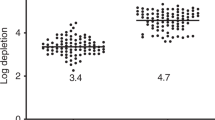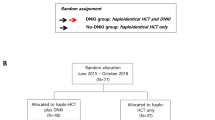Abstract
We analyzed donor-type chimerism in CD3+, CD14.15+ and CD56+ cells from 36 patients who had undergone conventional-intensity allogeneic stem cell transplantation (CST) and 34 patients who had undergone nonmyeloablative allogeneic stem cell transplantation (NST) for hematological malignancies. On day 28 after transplantation, all fractions in NST patients and CD3+ cells in CST patients who received a non-total body irradiation (TBI) regimen showed more frequent mixed chimerism (<90% donor cells) than those in patients who had received TBI. NST patients with acute graft-versus-host disease (grade II–IV) frequently showed more than 50% donor-type chimerism in CD3+ cells on day 14 (P=0.029). NST patients with <50% donor-type chimerism on day 14 and with <90% donor-type chimerism on day 28 in CD56+ cells had significantly poor 1-year overall survival (0 vs 91%, P<0.001 and 20 vs 74%, P=0.002, respectively). Both NST and CST patients with <90% donor-type chimerism in CD14.15+ cells on day 28 had significantly poor 1-year overall survival (14 vs 70%, P=0.005 and 0 vs 66%, P=0.002, respectively). Our data show that the extent of donor-type chimerism in lineage-specific cells appears to have an impact on outcome after allogeneic stem cell transplantation.
This is a preview of subscription content, access via your institution
Access options
Subscribe to this journal
Receive 12 print issues and online access
$259.00 per year
only $21.58 per issue
Buy this article
- Purchase on Springer Link
- Instant access to full article PDF
Prices may be subject to local taxes which are calculated during checkout

Similar content being viewed by others
References
Giralt S, Estey E, Albitar M, van Besien K, Rondon G, Anderlini P et al. Engraftment of allogeneic hematopoietic progenitor cells with purine analog-containing chemotherapy: harnessing graft-versus-leukemia without myeloablative therapy. Blood 1997; 89: 4531–4536.
Khouri IF, Keating M, Korbling M, Przepiorka D, Anderlini P, O'Brien S et al. Transplant-lite: induction of graft-versus-malignancy using fludarabine-based nonablative chemotherapy and allogeneic blood progenitor-cell transplantation as treatment for lymphoid malignancies. J Clin Oncol 1998; 16: 2817–2824.
Slavin S, Nagler A, Naparstek E, Kapelushnik Y, Aker M, Cividalli G et al. Nonmyeloablative stem cell transplantation and cell therapy as an alternative to conventional bone marrow transplantation with lethal cytoreduction for the treatment of malignant and nonmalignant hematologic diseases. Blood 1998; 91: 756–763.
Spitzer TR, McAfee S, Sackstein R, Colby C, Toh HC, Multani P et al. Intentional induction of mixed chimerism and achievement of antitumor responses after nonmyeloablative conditioning therapy and HLA-matched donor bone marrow transplantation for refractory hematologic malignancies. Biol Blood Marrow Transplant 2000; 6: 309–320.
McSweeney PA, Niederwieser D, Shizuru JA, Sandmaier BM, Molina AJ, Maloney DG et al. Hematopoietic cell transplantation in older patients with hematologic malignancies: replacing high-dose cytotoxic therapy with graft-versus-tumor effects. Blood 2001; 97: 3390–3400.
Giralt S, Thall PF, Khouri I, Wang X, Braunschweig I, Ippolitti C et al. Melphalan and purine analog-containing preparative regimens: reduced-intensity conditioning for patients with hematologic malignancies undergoing allogeneic progenitor cell transplantation. Blood 2001; 97: 631–637.
Childs R, Clave E, Contentin N, Jayasekera D, Hensel N, Leitman S et al. Engraftment kinetics after nonmyeloablative allogeneic peripheral blood stem cell transplantation: full donor T-cell chimerism precedes alloimmune responses. Blood 1999; 94: 3234–3241.
Antin JH, Childs R, Filipovich AH, Giralt S, Mackinnon S, Spitzer T et al. Establishment of complete and mixed donor chimerism after allogeneic lymphohematopoietic transplantation: recommendations from a workshop at the 2001 Tandem Meetings of the International Bone Marrow Transplant Registry and the American Society of Blood and Marrow Transplantation. Biol Blood Marrow Transplant 2001; 7: 473–485.
Keil F, Prinz E, Moser K, Mannhalter C, Kalhs P, Worel N et al. Rapid establishment of long-term culture-initiating cells of donor origin after nonmyeloablative allogeneic hematopoietic stem-cell transplantation, and significant prognostic impact of donor T-cell chimerism on stable engraftment and progression-free survival. Transplantation 2003; 76: 230–236.
Bornhauser M, Thiede C, Platzbecker U, Jenke A, Helwig A, Plettig R et al. Dose-reduced conditioning and allogeneic hematopoietic stem cell transplantation from unrelated donors in 42 patients. Clin Cancer Res 2001; 7: 2254–2262.
Tsutsumi Y, Tanaka J, Sugita J, Kato N, Zhang L, Yonezumi M et al. Analysis of T cell repertoire and mixed chimerism in a patient with aplastic anemia after allogeneic bone marrow transplantation. Br J Haematol 2002; 118: 136–139.
Tsutsumi Y, Tanaka J, Kato N, Zhang L, Mori A, Kobayasi R et al. Analysis of mixed chimerism in patients after allogeneic stem cell transplantation using a capillary electrophoresis system. Acta Haematol 2002; 107: 195–202.
Perez-Simon JA, Caballero D, Diez-Campelo M, Lopez-Perez R, Mateos G, Canizo C et al. Chimerism and minimal residual disease monitoring after reduced intensity conditioning (RIC) allogeneic transplantation. Leukemia 2002; 16: 1423–1431.
Thiede C, Lion T . Quantitative analysis of chimerism after allogeneic stem cell transplantation using multiplex PCR amplification of short tandem repeat markers and fluorescence detection. Leukemia 2001; 15: 303–306.
Fernandez-Aviles F, Urbano-Ispizua A, Aymerich M, Colomer D, Rovira M, Martinez C et al. Serial quantification of lymphoid and myeloid mixed chimerism using multiplex PCR amplification of short tandem repeat-markers predicts graft rejection and relapse, respectively, after allogeneic transplantation of CD34+ selected cells from peripheral blood. Leukemia 2003; 17: 613–620.
Valcarcel D, Martino R, Caballero D, Mateos MV, Perez-Simon JA, Canals C et al. Chimerism analysis following allogeneic peripheral blood stem cell transplantation with reduced-intensity conditioning. Bone Marrow Transplant 2003; 31: 387–392.
Baron F, Schaaf-Lafontaine N, Humblet-Baron S, Meuris N, Castermans E, Baudoux E et al. T-cell reconstitution after unmanipulated, CD8-depleted or CD34-selected nonmyeloablative peripheral blood stem-cell transplantation. Transplantation 2003; 76: 1705–1713.
Lee KH, Lee JH, Choi SJ, Lee JH, Kim S, Seol M et al. Monthly prospective analysis of hematopoietic chimerism after allogeneic hematopoietic cell transplantation. Bone Marrow Transplant 2003; 32: 423–431.
Petersen SL, Madsen HO, Ryder LP, Svejgaard A, Masmas TN, Dickmeiss E et al. Chimerism studies in HLA-identical nonmyeloablative hematopoietic stem cell transplantation point to the donor CD8(+) T-cell count on day +14 as a predictor of acute graft-versus-host disease. Biol Blood Marrow Transplant 2004; 10: 337–346.
Bader P, Niethammer D, Willasch A, Kreyenberg H, Klingebiel T . How and when should we monitor chimerism after allogeneic stem cell transplantation? Bone Marrow Transplant 2005; 35: 107–119.
Zeiser R, Spyridonidis A, Wasch R, Ihorst G, Grullich C, Bertz H et al. Evaluation of immunomodulatory treatment based on conventional and lineage-specific chimerism analysis in patients with myeloid malignancies after myeloablative allogeneic hematopoietic cell transplantation. Leukemia 2005; 19: 814–821.
Farag SS, Fehniger TA, Ruggeri L, Velardi A, Caligiuri MA . Natural killer cell receptors: new biology and insights into the graft-versus-leukemia effect. Blood 2002; 100: 1935–1947.
Ruggeri L, Capanni M, Urbani E, Perruccio K, Shlomchik WD, Tosti A et al. Effectiveness of donor natural killer cell alloreactivity in mismatched hematopoietic transplants. Science 2002; 295: 2097–2100.
Ruggeri L, Capanni M, Casucci M, Volpi I, Tosti A, Perruccio K et al. Role of natural killer cell alloreactivity in HLA-mismatched hematopoietic stem cell transplantation. Blood 1999; 94: 333–339.
Toubai T, Tanaka J, Mori A, Hashino S, Kobayashi S, Ota S et al. Etoposide, cyclophosphamide, and total body irradiation in allogeneic bone marrow transplantation for adult patients with hematological malignancies. Clin Transplant 2004; 18: 552–557.
Baron F, Maris MB, Sandmaier BM, Storer BE, Sorror M, Diaconescu R et al. Graft-versus-tumor effects after allogeneic hematopoietic cell transplantation with nonmyeloablative conditioning. J Clin Oncol 2005; 23: 1993–2003.
Lassaletta A, Ramirez M, Montero JM, Gonzalez-Vicent M, Balas A, Madero L et al. Full donor chimerism by day 30 after allogeneic peripheral blood progenitor cell transplantation is associated with a low risk of relapse in pediatric patients with hematological malignancies. Leukemia 2005; 19: 504–506.
Baron F, Baker JE, Storb R, Gooley TA, Sandmaier BM, Maris MB et al. Kinetics of engraftment in patients with hematologic malignancies given allogeneic hematopoietic cell transplantation after nonmyeloablative conditioning. Blood 2004; 104: 2254–2262.
Michallet AS, Furst S, Le QH, Dubois V, Praire A, Nicolini F et al. Impact of chimaerism analysis and kinetics on allogeneic haematopoietic stem cell transplantation outcome after conventional and reduced-intensity conditioning regimens. Br J Haematol 2005; 128: 676–689.
Acknowledgements
We thank all the physicians and nursing staff of the HSCT team and Ms M Yamane, Ms M Mayanagi and Y Ishimaru for their technical assistance. This work was supported in part by a grant from the Idiopathic Hematological Disease and Bone Marrow Transplantation Research Committee of the Ministry of Health and Welfare of Japan and by a Grant-in-Aid for Scientific Research from the Ministry of Education, Science and Culture of Japan.
Author information
Authors and Affiliations
Corresponding author
Rights and permissions
About this article
Cite this article
Miura, Y., Tanaka, J., Toubai, T. et al. Analysis of donor-type chimerism in lineage-specific cell populations after allogeneic myeloablative and nonmyeloablative stem cell transplantation. Bone Marrow Transplant 37, 837–843 (2006). https://doi.org/10.1038/sj.bmt.1705352
Received:
Revised:
Accepted:
Published:
Issue Date:
DOI: https://doi.org/10.1038/sj.bmt.1705352
Keywords
This article is cited by
-
Lineage-specific early complete donor chimerism and risk of relapse after allogeneic hematopoietic stem cell transplantation for acute myeloid leukemia
Bone Marrow Transplantation (2022)
-
Chimerism analysis for clinicians: a review of the literature and worldwide practices
Bone Marrow Transplantation (2022)
-
Chimerism status is correlated to acute graft-versus-host disease after allogeneic stem cell transplantation
International Journal of Hematology (2014)
-
Early recipient chimerism testing in the T- and NK-cell lineages for risk assessment of graft rejection in pediatric patients undergoing allogeneic stem cell transplantation
Leukemia (2012)
-
Donor cell leukemia after umbilical cord blood transplantation: recurrent or de novo? The importance of diagnosis for therapeutic decision making
International Journal of Hematology (2011)



